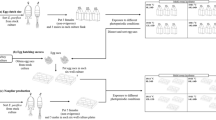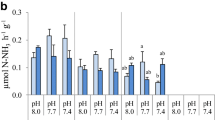Abstract
Green sea urchins, Strongylocentrotus droebachiensis OF Müller, collected off the coast of New Hampshire, USA, in late February 1995, were brought into the laboratory and fed an artificial diet ad libitum, and subjected to a photoperiod advanced by 4 months. During this study, temperatures and salinities for experimental urchins mirrored those recorded at the collection site. We examined the effects of changes in feeding regime and photoperiod on gametogenesis and compared the experimental urchins with those from the source population. During the 7-month period, experimental urchins showed no detectable changes in mean test height or diameter. Experimental urchins had a significantly higher gonad index (GI) in March, April and May (18 ± 6%) compared with field urchins in March (11 ± 3%). Subsequently, experimental urchins had a mean monthly GI of 25 to 30%, while the mean GI for field urchins was 11 to 13%. Gonial cell mitosis and gametogenesis occurred earlier in experimental male and female urchins compared with field urchins. Stereological and histological observations and stage–frequency data showed that the ovaries of experimental urchins were large because of the accelerated development of nutritive phagocytes, the volume fraction (V v) of which was 89 to 90% of the gonad, while new vitellogenic primary oocytes occupied <1% V v. In males, stereological and histological observations and stage–frequency data suggested a mobilization of materials from the nutritive phagocytes beginning between June and August, i.e. earlier than in females, and, by September, new gametes occupied a V v of 49 ± 3% of the testes. Oocyte size–frequency distributions demonstrated that most primary oocytes were <80 μm in diameter between March and September, suggesting that cold temperatures may be needed for completion of vitellogenesis. We describe changes in the two principal cell types in the germinal epithelium of urchin gonads and indicate how knowledge of their population dynamics may be useful in aquaculture applications.
Similar content being viewed by others


Author information
Authors and Affiliations
Additional information
Received: 21 February 1997 / Accepted: 3 June 1998
Rights and permissions
About this article
Cite this article
Walker, C., Lesser, M. Manipulation of food and photoperiod promotes out-of-season gametogenesis in the green sea urchin, Strongylocentrotus droebachiensis: implications for aquaculture. Marine Biology 132, 663–676 (1998). https://doi.org/10.1007/s002270050431
Issue Date:
DOI: https://doi.org/10.1007/s002270050431


